tow Citroen GRAND C4 PICASSO RHD 2017 2.G User Guide
[x] Cancel search | Manufacturer: CITROEN, Model Year: 2017, Model line: GRAND C4 PICASSO RHD, Model: Citroen GRAND C4 PICASSO RHD 2017 2.GPages: 523, PDF Size: 11.96 MB
Page 89 of 523

87
Repositioning a seat
Before operating the rear seats, check
that the outer rear seat belts are not
loose, to avoid damaging them. The
centre belt must be stowed. Fix the
tongues of the three belts to their
anchorage points.
Continuity panels
These continuity panels are not
designed to support a weight greater
than 30 kg.Releasing / locking the continuity panels
F
B
efore unfolding the continuity panels,
check that the seats in the 2
nd row are fully
back.
F
S
lide the continuity panel latch upwards to
release.
F
S
traighten the continuity panel, then slide
the latch downwards to lock it.
F
I
f necessary, straighten the continuity
panels for the seats in the 2
nd row and lock
them in place.
F
R
aise the backrest and push it rear wards
until it locks in position Each seat has a continuity panel at the bottom
of the backrest, that once unfolded:
-
p rovides a continuous load sur face in the
boot, whatever the position of the seats,
-
a
voids objects sliding under the seats in
the 2
nd row.
3
Ease of use and comfort
Page 90 of 523
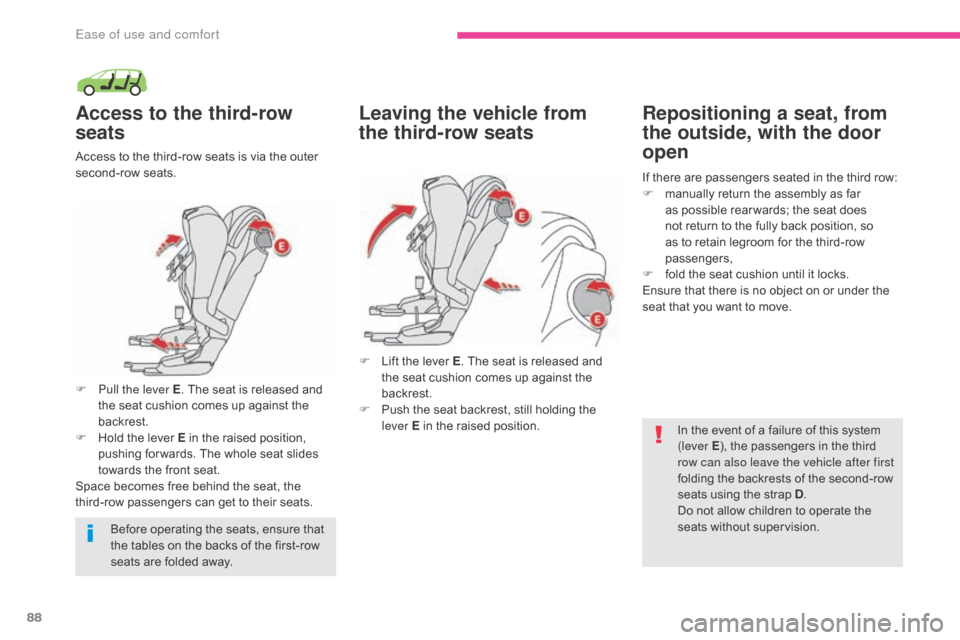
88
Access to the third-row
seats
Access to the third-row seats is via the outer
second-row seats.
F
P
ull the lever E . The seat is released and
the seat cushion comes up against the
backrest.
F
H
old the lever E in the raised position,
pushing for wards. The whole seat slides
towards the front seat.
Space becomes free behind the seat, the
third-row passengers can get to their seats.
Leaving the vehicle from
the third-row seats Repositioning a seat, from
the outside, with the door
open
In the event of a failure of this system
(lever E
), the passengers in the third
row can also leave the vehicle after first
folding the backrests of the second-row
seats using the strap D .
Do not allow children to operate the
seats without supervision.
F
L
ift the lever E
. The seat is released and
the seat cushion comes up against the
backrest.
F
P
ush the seat backrest, still holding the
lever E in the raised position. If there are passengers seated in the third row:
F
m
anually return the assembly as far
as possible rear wards; the seat does
not return to the fully back position, so
as to retain legroom for the third-row
passengers,
F
f
old the seat cushion until it locks.
Ensure that there is no object on or under the
seat that you want to move.
Before operating the seats, ensure that
the tables on the backs of the first-row
seats are folded away.
Ease of use and comfort
Page 92 of 523
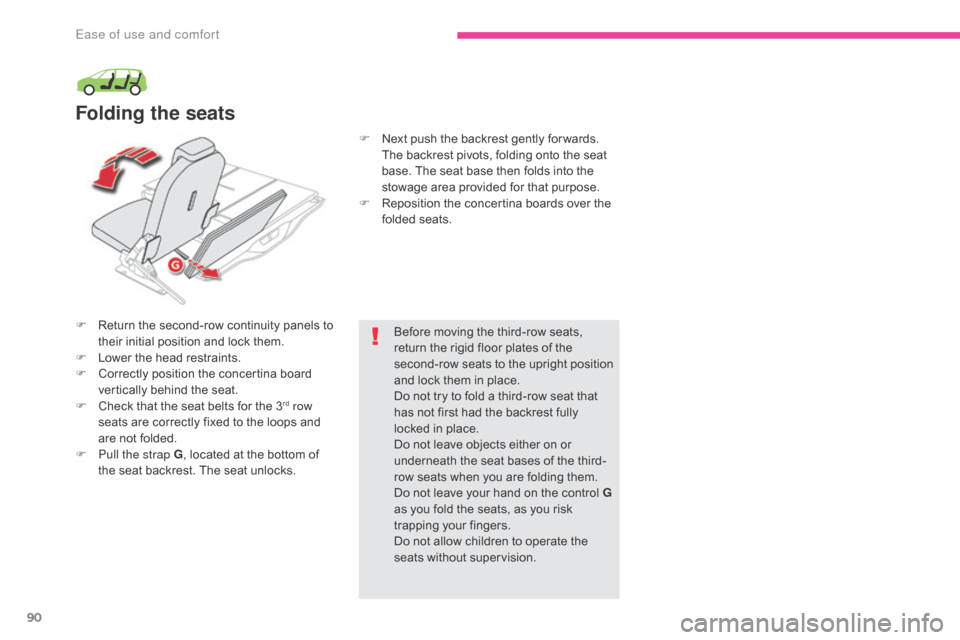
90
F Return the second-row continuity panels to their initial position and lock them.
F
L
ower the head restraints.
F
C
orrectly position the concertina board
vertically behind the seat.
F
C
heck that the seat belts for the 3
rd row
seats are correctly fixed to the loops and
are not folded.
F
P
ull the strap G , located at the bottom of
the seat backrest. The seat unlocks. Before moving the third-row seats,
return the rigid floor plates of the
second-row seats to the upright position
and lock them in place.
Do not try to fold a third-row seat that
has not first had the backrest fully
locked in place.
Do not leave objects either on or
underneath the seat bases of the third-
row seats when you are folding them.
Do not leave your hand on the control
G
as you fold the seats, as you risk
trapping your fingers.
Do not allow children to operate the
seats without supervision.
F
N
ext push the backrest gently for wards.
The backrest pivots, folding onto the seat
base. The seat base then folds into the
stowage area provided for that purpose.
F
R
eposition the concertina boards over the
folded seats.
Folding the seats
Ease of use and comfort
Page 97 of 523
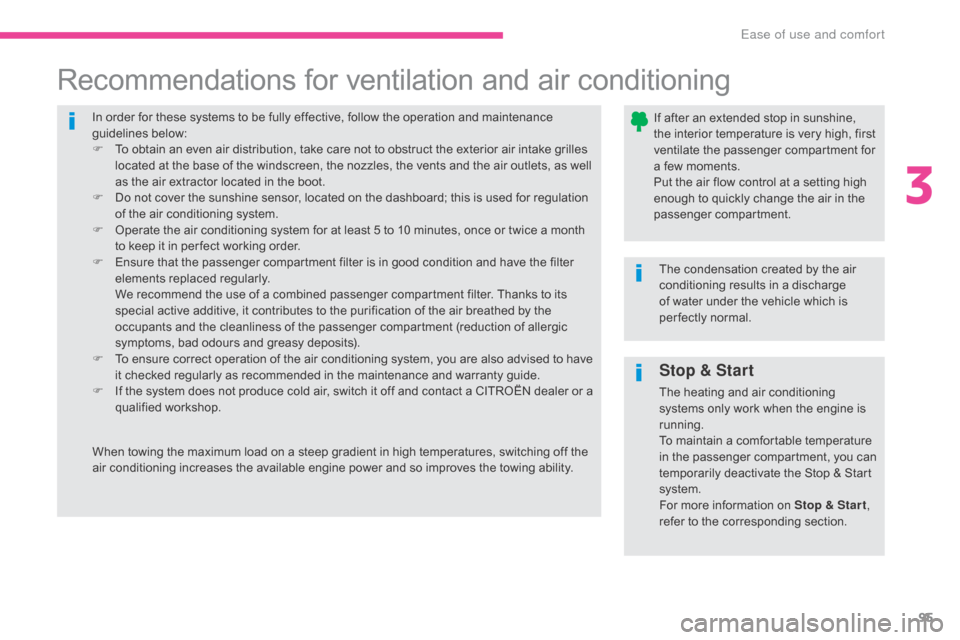
95
In order for these systems to be fully effective, follow the operation and maintenance
guidelines below:
F
T
o obtain an even air distribution, take care not to obstruct the exterior air intake grilles
located at the base of the windscreen, the nozzles, the vents and the air outlets, as well
as the air extractor located in the boot.
F
D
o not cover the sunshine sensor, located on the dashboard; this is used for regulation
of the air conditioning system.
F
O
perate the air conditioning system for at least 5 to 10 minutes, once or twice a month
to keep it in per fect working order.
F
E
nsure that the passenger compartment filter is in good condition and have the filter
elements replaced regularly.
W
e recommend the use of a combined passenger compartment filter. Thanks to its
special active additive, it contributes to the purification of the air breathed by the
occupants and the cleanliness of the passenger compartment (reduction of allergic
symptoms, bad odours and greasy deposits).
F
T
o ensure correct operation of the air conditioning system, you are also advised to have
it checked regularly as recommended in the maintenance and warranty guide.
F
I
f the system does not produce cold air, switch it off and contact a CITROËN dealer or a
qualified workshop.
Recommendations for ventilation and air conditioning
If after an extended stop in sunshine,
the interior temperature is very high, first
ventilate the passenger compartment for
a few moments.
Put the air flow control at a setting high
enough to quickly change the air in the
passenger compartment.
The condensation created by the air
conditioning results in a discharge
of water under the vehicle which is
per fectly normal.
When towing the maximum load on a steep gradient in high temperatures, switching off the
air conditioning increases the available engine power and so improves the towing ability.
Stop & Start
The heating and air conditioning
systems only work when the engine is
running.
To maintain a comfortable temperature
in the passenger compartment, you can
temporarily deactivate the Stop & Start
system.
For more information on Stop & Star t ,
refer to the corresponding section.
3
Ease of use and comfort
Page 106 of 523

104
Front demist -
defrost
F Press this button to demist or defrost the windscreen and side
windows as quickly as possible.
The indicator lamp in the button
comes on.
With Stop & Start, when demisting has
been activated, the STOP mode is not
available.
The system automatically manages the air
conditioning (depending on version), air
flow and air intake, and provides optimum
distribution towards the windscreen and side
windows.
F
T
o switch it off press this button again or
adjust the setting for air flow or distribution.
The indicator lamp goes off.
Rear screen demist -
defrost
Switching on
Switching off
F Press this button to demist / defrost the rear screen and
(depending on version) the door
mirrors.
The demisting/defrosting switches off automatically
to prevent an excessive consumption of current.
The rear screen demist - defrost
can only operate when the engine is
running.
Switch off the heating of the rear screen
and door mirrors as soon as you judge it
possible, as reducing the consumption
of electrical current reduces fuel
consumption.
F
I
t is possible to stop the
demisting/defrosting operation
before it is switched off
automatically by pressing the
button again.
The indicator lamp associated with the button
goes off.
The indicator lamp associated with the button comes on.
Ease of use and comfort
Page 111 of 523
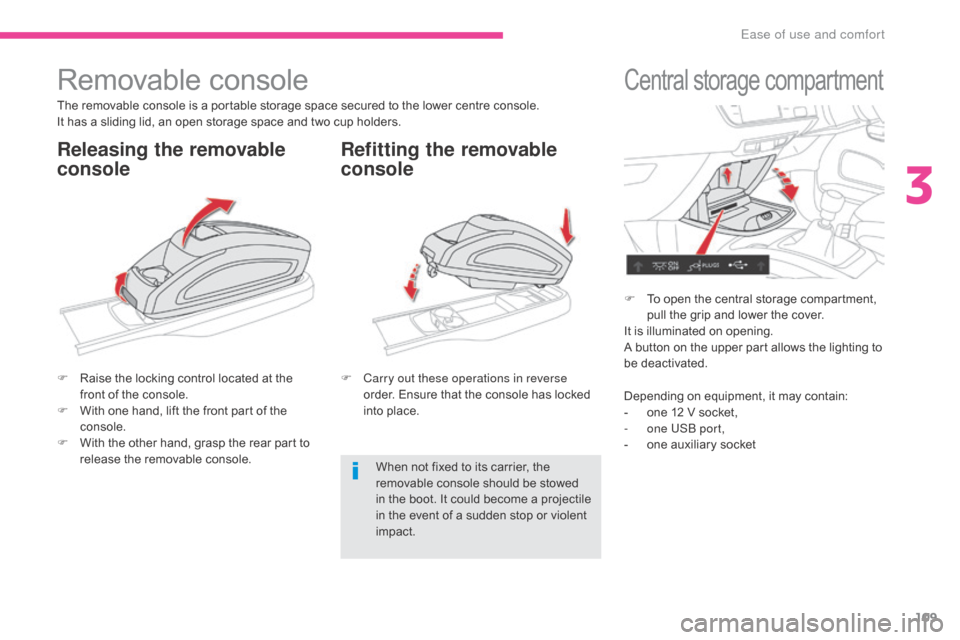
109
Removable console
The removable console is a portable storage space secured to the lower centre console.
It has a sliding lid, an open storage space and two cup holders.
F
R
aise the locking control located at the
front of the console.
F
W
ith one hand, lift the front part of the
console.
F
W
ith the other hand, grasp the rear part to
release the removable console. F
C
arry out these operations in reverse
order. Ensure that the console has locked
into place.
When not fixed to its carrier, the
removable console should be stowed
in the boot. It could become a projectile
in the event of a sudden stop or violent
impact.
Releasing the removable
console Refitting the removable
console
Central storage compartment
F To open the central storage compartment,
pull the grip and lower the cover.
It is illuminated on opening.
A button on the upper part allows the lighting to
be deactivated.
Depending on equipment, it may contain:
-
o
ne 12 V socket,
-
o
ne USB port,
-
o
ne auxiliary socket
3
Ease of use and comfort
Page 114 of 523
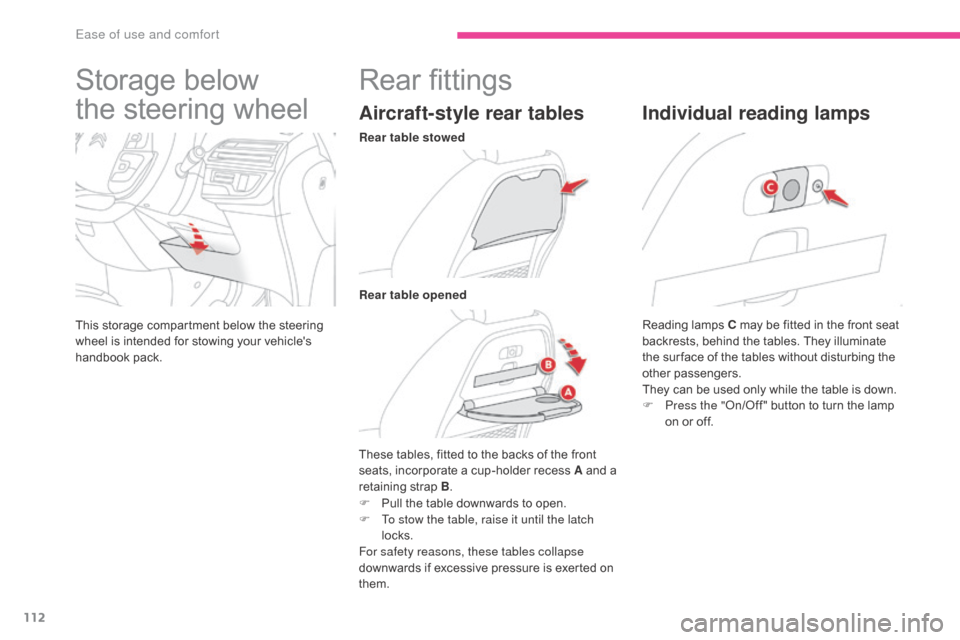
112
Storage below
the steering wheel
This storage compartment below the steering
wheel is intended for stowing your vehicle's
handbook pack.
Rear fittings
Aircraft-style rear tables
These tables, fitted to the backs of the front
seats, incorporate a cup-holder recess A and a
retaining strap B .
F
P
ull the table downwards to open.
F
T
o stow the table, raise it until the latch
locks.
For safety reasons, these tables collapse
downwards if excessive pressure is exerted on
them. Reading lamps C may be fitted in the front seat
backrests, behind the tables. They illuminate
the sur face of the tables without disturbing the
other passengers.
They can be used only while the table is down.
F
P
ress the "
On/Of
f " button to turn the lamp
on or off.
Individual reading lamps
Rear table stowed
Rear table opened
Ease of use and comfort
Page 118 of 523
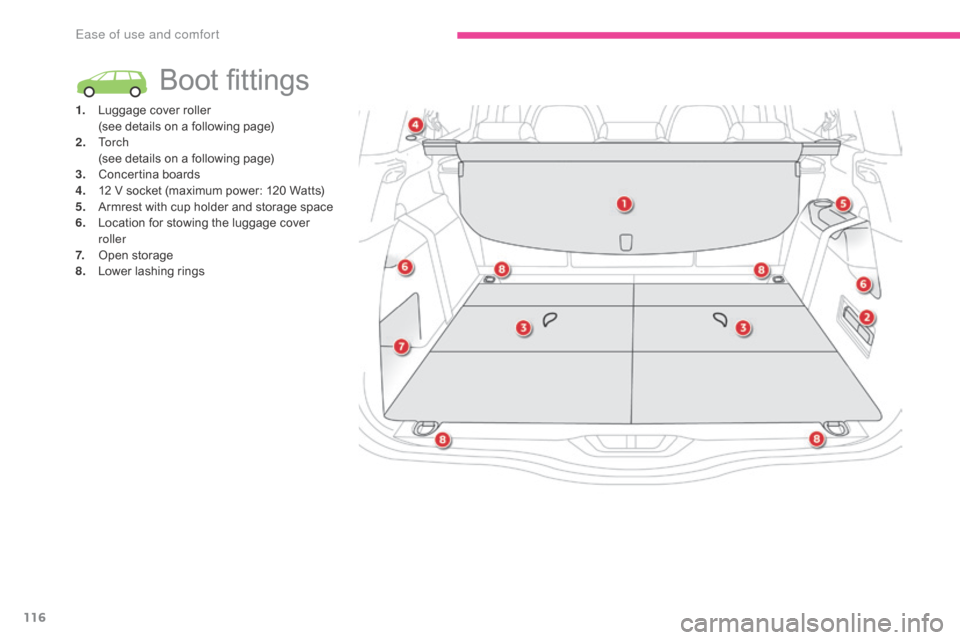
116
Boot fittings
1. Luggage cover roller (see details on a following page)
2.
T
o r c h
(
see details on a following page)
3.
C
oncertina boards
4.
1
2 V socket (maximum power: 120 Watts)
5.
A
rmrest with cup holder and storage space
6.
L
ocation for stowing the luggage cover
roller
7.
O
pen storage
8.
L
ower lashing rings
Ease of use and comfort
Page 119 of 523
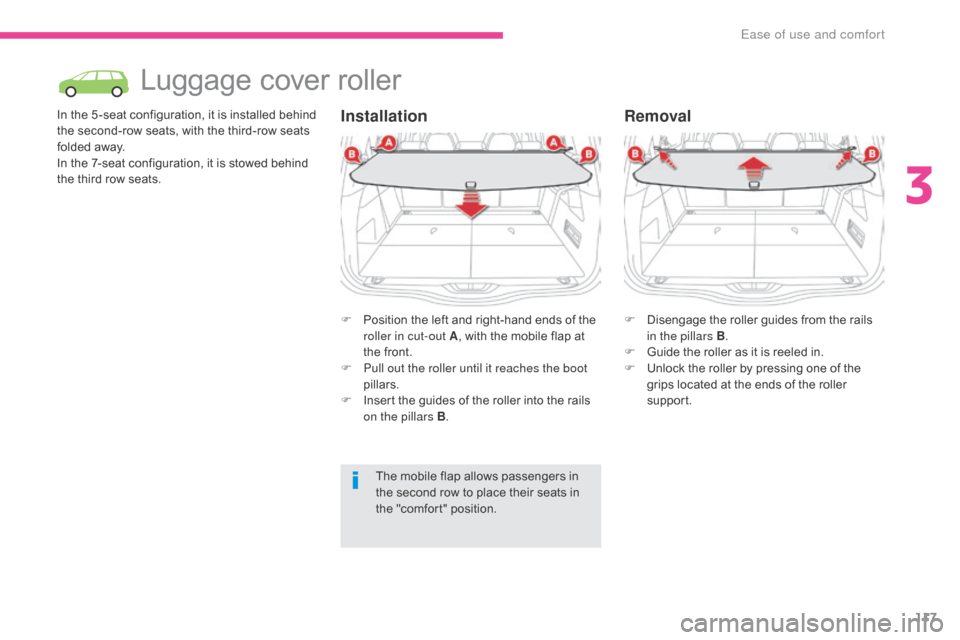
117
Luggage cover roller
In the 5 -seat configuration, it is installed behind
the second-row seats, with the third-row seats
folded away.
In the 7-seat configuration, it is stowed behind
the third row seats.F
P
osition the left and right-hand ends of the
roller in cut-out A , with the mobile flap at
the front.
F
P
ull out the roller until it reaches the boot
pillars.
F
I
nsert the guides of the roller into the rails
on the pillars B . F
D
isengage the roller guides from the rails
in the pillars B .
F
G
uide the roller as it is reeled in.
F
U
nlock the roller by pressing one of the
grips located at the ends of the roller
support.
The mobile flap allows passengers in
the second row to place their seats in
the "comfort" position.Installation Removal
3
Ease of use and comfort
Page 120 of 523

118
Stowing behind the 3rd row seats
To fold the 3rd row seats with the roller
stowed at the rear, it is necessary to raise the
concertina boards in order to allow access to
the seat locking controls (red straps).
F
E
nsure that the 3rd row seats are folded.
F
F
old the first two concertina boards.
F
I
nstall the roller in the space above the arm
rest, one side after the other, inclining it
s li g ht l y.
F
S
lide the roller as far as it will go, up to the
cut-outs provided at the back of the boot,
with the two flaps directed downwards.
F
U
nfold the third row seats.
The folded concertina boards can be
positioned horizontally or vertically.
Ease of use and comfort